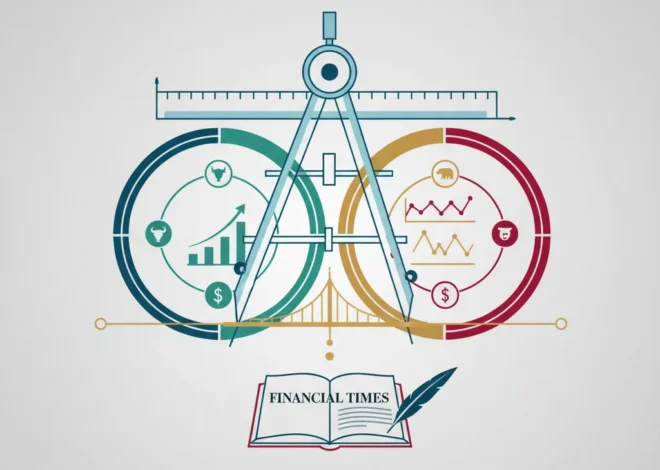
Market Crossroads: 5 Critical Signals for Investors to Watch This Week
Navigating a Pivotal Week in Global Finance
The global financial markets are holding their breath. After a period of relative calm fueled by optimism about potential interest rate cuts, investors are now facing a week packed with critical economic data and central bank decisions that could set the tone for the rest of the summer. The central narrative remains a tug-of-war between persistent inflation and the desire for monetary policy easing. For anyone involved in investing, trading, or corporate strategy, this week’s events are not just numbers on a screen; they are crucial signals about the health of the global economy and the future direction of the stock market.
This week, the focus sharpens on five key areas: U.S. inflation and consumer spending data will test the Federal Reserve’s patience, while central bankers on both sides of the Atlantic are set to provide fresh guidance. From Washington to London and across the Eurozone, the data released will have significant implications for everything from banking profitability to the pace of fintech innovation. Let’s break down the five things you need to watch.
1. The Inflation Tightrope: All Eyes on U.S. CPI and PPI
The main event for the U.S. markets this week is undoubtedly the release of the latest inflation data. Both the Consumer Price Index (CPI) and the Producer Price Index (PPI) will be scrutinized with microscopic intensity. These are not just academic figures; they are the primary data points influencing the Federal Reserve’s decisions on interest rates, which have a ripple effect across the entire financial system.
The CPI measures the average change over time in the prices paid by urban consumers for a market basket of consumer goods and services. The PPI, on the other hand, tracks the selling prices received by domestic producers. Together, they provide a comprehensive picture of price pressures in the economy. The Fed has repeatedly stated its commitment to bringing inflation back down to its 2% annual target, and any deviation from the expected cooling trend could cause significant market volatility.
Why It Matters: A hotter-than-expected inflation report could dash hopes for a near-term rate cut, potentially sending bond yields higher and putting downward pressure on equities, especially in growth-oriented sectors like technology and financial technology. Conversely, a soft reading would bolster the case for the Fed to begin easing policy, likely providing a tailwind for the stock market. For the banking sector, sustained high rates can boost net interest margins but also risk slowing loan growth and increasing default rates. This week’s data is a critical piece of that puzzle.
2. The American Consumer: A Barometer of Economic Strength
Is the U.S. consumer finally starting to buckle under the pressure of higher prices and elevated borrowing costs? This week’s retail sales report will offer a vital clue. Consumer spending is the bedrock of the U.S. economy, accounting for roughly two-thirds of all economic activity. Therefore, this report is a direct pulse check on the nation’s financial health.
Recent data has been mixed, with some signs of consumer resilience but also growing indications of strain, such as rising credit card delinquencies. Economists and investors will be looking for signs of either continued strength or a more pronounced slowdown. A strong report would suggest the economy is still running hot, complicating the Fed’s inflation fight. A weak report, however, could signal a looming recession, potentially forcing the Fed’s hand to cut rates sooner to support growth.
Below is a quick look at the market’s expectations for this crucial data point.
| Retail Sales Indicator | Previous Reading (Month-over-Month) | Economist Forecast (Month-over-Month) |
|---|---|---|
| Headline Retail Sales | 0.0% (source) | +0.3% |
| Retail Sales (Ex-Autos) | +0.2% | +0.2% |
The divergence between the headline and “ex-autos” figures will be important. A slight uptick is expected, but any significant miss in either direction will move markets. This data directly impacts retail stocks, payment processors in the fintech space, and the broader economic outlook.
3. Fed-Speak: Deciphering the Central Bank’s Language
In the absence of an official policy meeting, the next best thing is hearing directly from the policymakers themselves. This week features a packed schedule of appearances from several Federal Reserve officials, and market participants will be hanging on their every word. Speeches from influential figures like New York Fed President John Williams and Philadelphia Fed President Patrick Harker will be particularly noteworthy.
Investors and analysts will parse their language for any subtle shifts in tone regarding inflation, the labor market, and the overall economic outlook. Are they sounding more “hawkish” (concerned about inflation, leaning towards higher rates for longer) or more “dovish” (concerned about growth, leaning towards rate cuts)? Their commentary provides crucial context around the hard data and can significantly influence market expectations for future Fed actions. This is a key part of modern economics, where central bank communication is a policy tool in itself.
4. Across the Pond: A High-Stakes Bank of England Decision
The focus isn’t solely on the U.S. this week. The Bank of England (BoE) is set to announce its latest monetary policy decision, and while no change in the 5.25% interest rate is expected, the meeting is far from a non-event. The context is critical: the UK is in the midst of a general election campaign, and inflation has been stickier than in other developed economies.
The BoE is in a delicate position. While the European Central Bank has already started its rate-cutting cycle, the BoE has remained on hold. The key details to watch in this announcement will be the vote split among the Monetary Policy Committee members and the forward guidance in the meeting minutes. An increase in the number of members voting for a rate cut would be a strong signal that an August move is on the table, which could weigh on the British pound but support UK equities.
Here’s a breakdown of potential scenarios and their likely market impact:
| Scenario | Description | Potential Market Impact |
|---|---|---|
| Hawkish Hold (7-2 Vote) | The BoE holds rates with the same vote split as last time, emphasizing data dependency and persistent inflation. | GBP strengthens, UK stock market (FTSE) may face pressure. |
| Dovish Hold (6-3 or 5-4 Vote) | More members vote for a rate cut, and the statement strongly hints at an August cut. This is the market’s base case (source). | GBP weakens, UK stocks could rally on prospect of lower rates. |
| Surprise Cut | The BoE unexpectedly cuts rates by 25 basis points. Highly unlikely given the ongoing election. | Significant GBP weakness, sharp rally in UK equities and bonds. |
5. Eurozone’s Economic Pulse Check: Flash PMI Data
Rounding out the week, the release of flash Purchasing Managers’ Index (PMI) data from the Eurozone will provide a timely snapshot of the bloc’s economic health. These surveys measure the activity levels of purchasing managers in the manufacturing and services sectors, making them excellent leading indicators of economic growth.
After the European Central Bank’s recent interest rate cut, markets are eager to see if the region’s economy is responding positively. Stronger-than-expected PMI figures would suggest the Eurozone is on a firmer recovery path, potentially limiting the scope for further aggressive rate cuts from the ECB. Weaker data, however, would reinforce the view that more monetary stimulus is needed to stave off economic stagnation. For those with exposure to European assets, this data is a crucial indicator of the continent’s near-term economic trajectory and has implications for the currency, bond, and stock market dynamics.
Conclusion: A Week of Reckoning
This week serves as a critical juncture for the global markets. The themes are clear: the path of inflation, the resilience of the consumer, and the reaction function of the world’s most powerful central banks. The data and decisions made over the next few days will provide much-needed clarity on the direction of the global economy and will undoubtedly drive significant movements in trading across all asset classes. For investors, finance professionals, and business leaders, staying informed and agile will be paramount to successfully navigating the challenges and opportunities that lie ahead.


